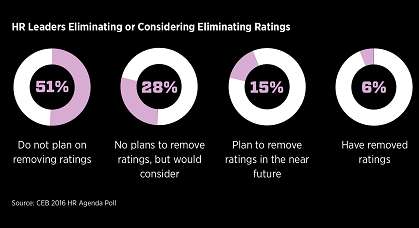CTDO Magazine Article
Are Performance Reviews Worth Reviving?
The unintended consequences of eliminating annual ratings.
Thu Sep 15 2016

There's a lot of chatter among talent leaders promoting the overhaul—and even elimination—of typical performance reviews. To better understand the impact that performance ratings have, CEB surveyed nearly 10,000 employees in its 2016 Pay for Performance Employee Survey. These employees were from across the globe, spanning 18 countries, and from a representative sample of industries and organizational sizes. CEB compared the outcomes and perceptions of those employees in organizations that use performance ratings with those in organizations without ratings.
The Real Impact of Eliminating Performance Ratings found that only 4 percent of HR leaders feel they are effective at accurately assessing employee performance. The reasons are clear: The process is most often time-consuming, overly administrative, and disconnected from day-to-day work and the behaviors that actually improve employee performance.
It's well established that performance management systems need to change in most organizations. CEB reports that 41 percent of companies want some sort of change to their current system, and one in three (33 percent) believe significant changes are necessary. Meanwhile, 6 percent report that they already have removed ratings, with another 15 percent saying they have plans to remove ratings in the future.
If you read the headlines, initial reactions from employees and managers about removing ratings are positive. But those good vibes tend to fade after the first performance review cycle, according to the CEB research. The data analysis finds that at most companies, employee performance drops by nearly 10 percent when ratings are removed because of breakdowns in managers' ability to manage, and a fall in employee engagement.

CEB analysis shows that eliminating ratings leads to four unintended outcomes:
Manager conversation quality declines by 14 percent because managers struggle to explain to employees how they performed in the past and what steps to take to improve future performance.
Managers have more time, but time spent on informal conversations decreases by 10 hours because managers do not shift that extra time toward ongoing, informal performance conversations.
Top performers' satisfaction with pay differentiation decreases by 8 percent because managers have trouble explaining how pay decisions are made and linked to individual contributions.
Employee engagement drops by 6 percent because managers are unable to do the very things that are proved to engage employees, such as set expectations for their team, hold clear performance and development conversations, and provide appropriate rewards and recognition.
Rather than getting sidetracked by the ratings debate, CEB suggests that all companies try to improve their performance management in three—mostly common sense—ways:
Provide ongoing, not episodic, performance feedback. Increasing the frequency of informal performance conversations enables managers to provide more timely feedback to employees and to adjust expectations about what's required from an employee given recent organizational changes or her past performance. This can improve employee performance by up to 12 percent, according to CEB's analysis.
Make performance reviews forward looking, not backward looking. Assessing and discussing future performance provides managers and employees with a more accurate understanding of their abilities to meet future business needs and how to improve those abilities.
Include peer feedback. Collecting feedback from peers who understand employees' work helps managers assess and discuss employee performance in an environment where employees must increasingly work with peers to be effective.
Read more from CTDO magazine: Essential talent development content for C-suite leaders.
